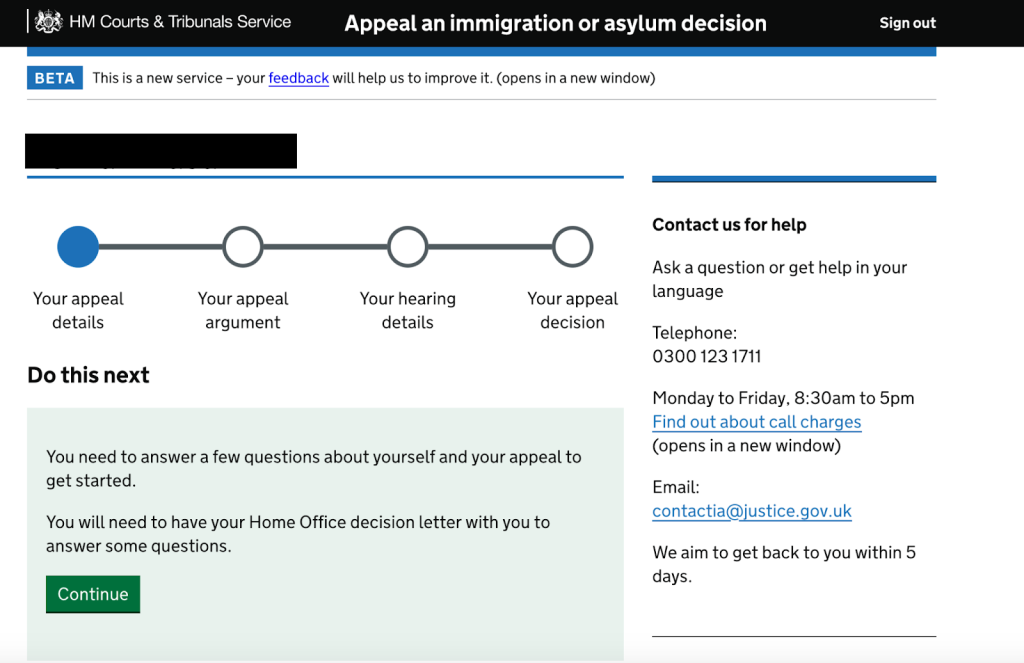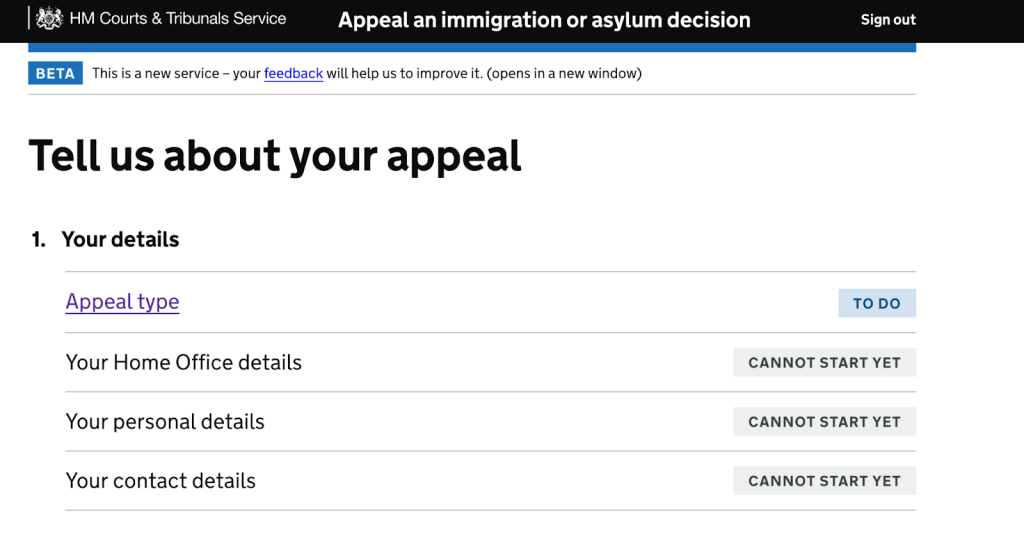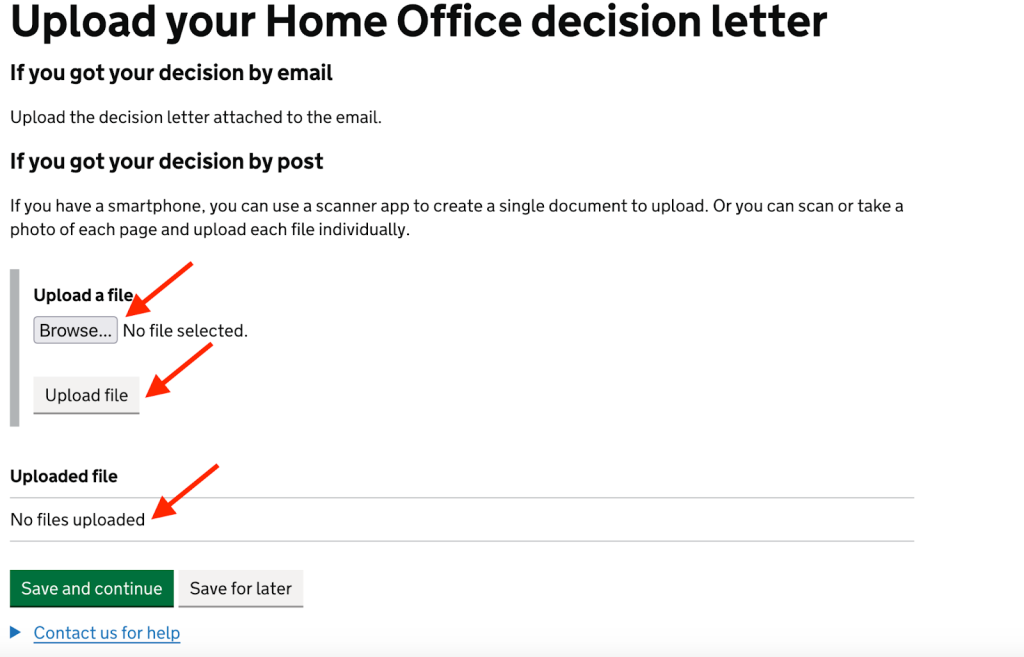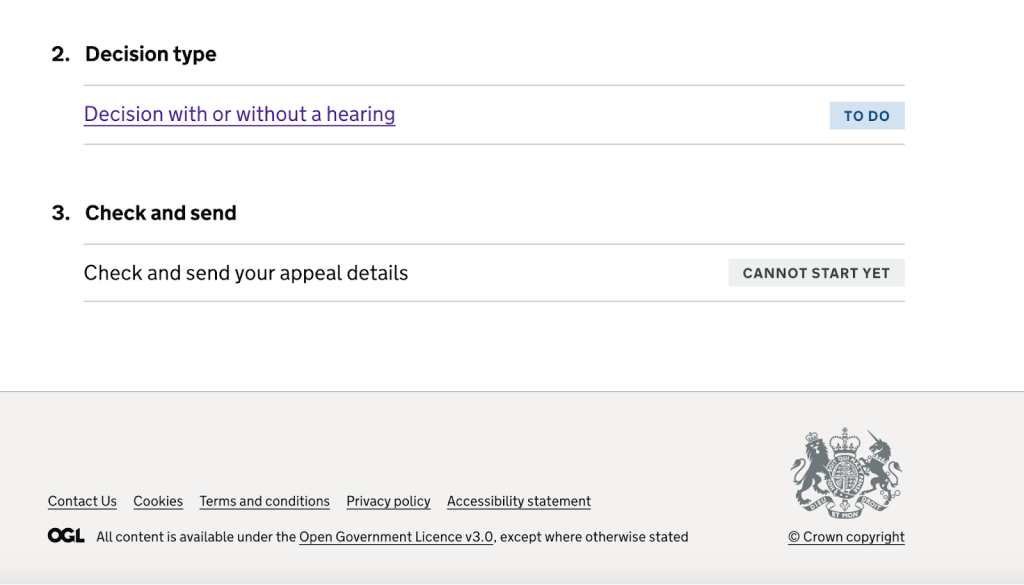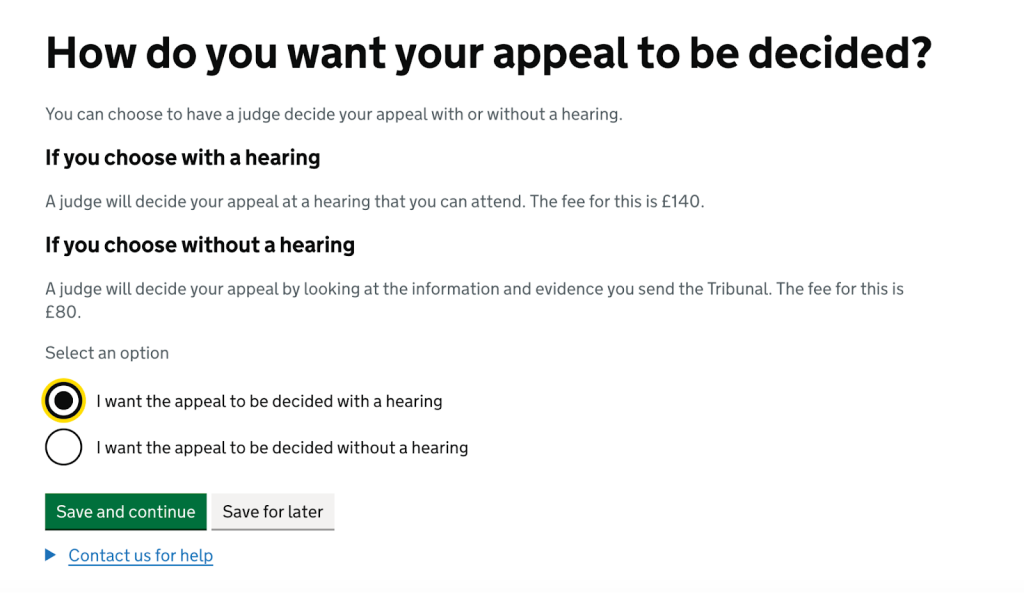Last Updated: 17 April 2024
An appeal is a formal legal challenge of a Home Office decision.
Read this page to find out how to submit an appeal, what happens after you have submitted your appeal, and what you should do before your appeal hearing.
This page assumes that you do not have a lawyer. However, you should read this page even if you do have a lawyer as it is important to understand your own case.
To read about what happens on the day of an appeal hearing, and tips for representing yourself, you can read our Toolkit page on Your Appeal Hearing at the First-tier Tribunal.
On this page, you will find the following information:
- What is an appeal?
- Useful words
- Do you have a right of appeal?
- What if I don’t have a right of appeal?
- Guide to submitting your appeal online
- Adjournment and delays
- Preparing for your hearing
There is a lot of information on this page, which might feel overwhelming. It may be helpful to watch our video about appeals before you read this page.
What is an appeal?
If the Home Office refuses your application, you may have the right to appeal the decision. This involves asking an Immigration Tribunal (a type of court) to review the evidence in your case, and make a new decision.
An appeal is different from a judicial review. To find out more about judicial reviews, read the Judicial Reviews page of our guide.
USEFUL WORDS
When you submit an appeal, you may come across unfamiliar words and phrases. Below are a few definitions that might be useful to know:
Appellant: This is you!
Respondent: This is the Home Office. You might also hear people use the phrase, ‘Secretary of State for the Home Department’, the ‘Home Secretary’, or ‘SSHD’.
Party to Proceedings: This is used to describe both you and the Home Office. If you read the phrase “parties must provide…” it is referring to both the appellant (you) and the respondent (the Home Office).
Immigration Judge: The judge is responsible for considering the evidence in your case. They will decide whether the original Home Office decision was correct or not.
The Hearing or The Substantive Hearing: This describes your time in court. At your substantive hearing, you will be given the chance to tell the judge why you think the Home Office was wrong to refuse your application. If you have a lawyer, they will be telling the judge this information, but you will also have a chance to share your story.
Home Office Presenting Officer (HOPO): The HOPO is employed by the Home Office and may represent the Home Office at your hearing. They will be arguing that your case should be dismissed.
Determination: This word is used to describe the judge’s decision.
Appeal Allowed: If your appeal is allowed, this means that the judge has decided that your claim should be accepted.
Appeal Dismissed: If your appeal is dismissed, this means that the judge has decided that your claim should be refused.
Lodging an Appeal: this just means submitting an appeal.
Notice: This word is used to describe important information, usually in writing, communicated by the Tribunal or one of the parties. When you submit your appeal, you are sending a Notice of Appeal. When the Tribunal sends you a letter with the date of your hearing, this is called a Hearing Notice.
File: Filing a document just means sending it to the Tribunal ahead of the hearing.
Directions: These are instructions from the Tribunal. They will tell you what you need to do next.
Bundle: This word is used to describe a collection of important documents. The appellant bundle is submitted to the Tribunal by you (the appellant) and will contain all the documents that you would like the judge to see. This will include evidence that you are relying on, such as country of origin information. The respondent bundle will be prepared by the Home Office and will include documents that they wish to rely on. You will need to send a copy of the appellant bundle to the Tribunal and the respondent (Home Office). You can read more about bundles below.
Adjournment: An adjournment is when the hearing date is moved back (delayed). You can read more about adjournments below.
First-tier Tribunal: For most people, the First-tier Tribunal is the first court you have access to if you are appealing a refusal by the Home Office.
Upper Tribunal: If you lose your appeal at the First-tier Tribunal, you may be able to appeal again at the Upper Tribunal. This is the court one level above the First-tier Tribunal.
Immigration and Asylum Chamber: Together, the First-tier Tribunal and Upper Tribunal form the Immigration and Asylum Chamber. A Chamber is a section of the UK court system which deals with legal disputes in a particular area of law.

Do you have a right of appeal?
Not all Home Office decisions come with a right of appeal. Your Home Office decision letter should tell you whether you have an appeal right.
You can appeal a decision if the Home Office has:
- refused your protection claim (also known as ‘asylum claim’ or ‘humanitarian protection’)
- refused your human rights claim (this includes claims raising health, family and private life grounds)
- revoked (this means taken away) your protection status
- revoked your British citizenship
- refused you a residence document or deported you under the Immigration (European Economic Area) Regulations 2016
- refused or revoked your status, varied (changed) the length or condition of your stay, or deported you under the EU Settlement Scheme
- refused or revoked your travel permit or family permit under the EU Settlement Scheme or restricted your rights to enter or leave the UK under those permits
- refused or revoked your permit, or deported you if you’re a frontier worker
- refused or revoked your leave, or deported you if you’re an S2 healthcare visitor
Not all protection and human rights claims come with a right of appeal. You do not have the right of appeal if your asylum or human rights claim is certified (this means denied) by the Home Office for being “clearly unfounded”. If your claim is certified, it may be possible to challenge the certification of your claim through a judicial review.
If you made another type of application (that isn’t in the list above) before 6 April 2015 you may still have the right of appeal if you are refused. See the Home Office website for more information here.
What if I don’t have the right to appeal?
Administrative review
If you do not have the right of appeal, you may be able to apply for administrative review from the Home Office. An administrative review is a request to have your decision reviewed, and it takes about 12 months. Only certain types of applications allow an administrative review if refused. Read more about administrative reviews on the Home Office website here.
Judicial review
If you do not have the right of appeal, you may wish to look at whether a judicial review is possible in your situation. A judicial review is not the same as an appeal – an appeal looks substantively at the issues of your case. A judicial review looks only at how the decision on your case was made (the procedure).
Read more on the Judicial Reviews page of this guide.
Guide to submitting your appeal online
This guide was created at the suggestion of and in collaboration with Rainbow Migration. Many thanks to colleagues there for their wisdom, support, and tips.
If you do not have a lawyer and need to submit your appeal within 14 days of a Home Office refusal decision, you can do this online yourself. It is important you do not miss this deadline.
You do not need to include any legal arguments or evidence when you submit your appeal, you can do this later once you have found legal representation or received legal advice.
If you missed the deadline and your appeal is late, please seek legal advice before submitting your appeal online.
Visit the government website to learn about how to submit an appeal online here.
ACTION SECTION
STEP 1: When you sit down to submit your appeal online, make sure you have all the below information with you, and that you have enough time to complete the whole application, because you must complete each section of the application before moving onto the next. If at any point you need to stop filling in the online form, you can click on ‘Save for later’ so anything you have completed is saved. You can then log back in later and continue.
Make sure you have:
- Your Home Office reference number – usually on the refusal letter, and
- A copy of the Home Office refusal letter saved in PDF format because the system sometimes will not allow other formats such as pictures (you can create a PDF on a computer, or by Googling ‘create free PDF’), and
- An email address or phone number you would like to use.
STEP 2: Visit this website to create an account.
STEP 3: Create an account using your preferred email address. You should see a page asking you to go to your email inbox to follow the instructions to finish creating your account. You should then receive an automated email from HM Courts and Tribunals Registrations asking you to confirm your email address. Click on the link that says ‘Confirm your email address’.
STEP 4: You will then be taken to a page that asks you to create a password. Make sure you use a password you will remember, but that is strong. Keep a record of your password somewhere safe. Then click ‘Continue’.
STEP 5: You will be taken to a page to confirm your account has been created, and you can now sign in. Click ‘Continue’. You will then be taken back to the account page. Ensure your email and password are entered correctly then click ‘Sign in’.
STEP 6: Once you have signed in, you will be taken to a page that looks like this.
This account is where you will be able to monitor the progress of your appeal. To start the process of submitting your appeal online, click ‘Continue’.
STEP 7: You will be taken to a page that says ‘Tell us about your appeal’. This is like the menu page for filling out the different sections of the application. The first section you need to fill in is called ‘1. Your details.’ Remember, you need to finish each section before you start the next section.
Begin by clicking the link that says ‘Appeal Type’ and input the following answers:
- If you are currently living in the UK, click ‘Yes’ and click ‘Continue’;
- If you are claiming asylum, then click ‘Protection’ for ‘What is your appeal type?’. Then click ‘Save and continue’.
- Note: You can only select one option, so even if you have human rights as part of your claim just select ‘Protection’ for now. You can inform the Tribunal of other issues later.
Remember, if at any point you need to stop filling in the online form, you can click on ‘Save for later’ so anything you have completed is saved. You can then log back in when possible and continue.
STEP 8: After this, you will be taken back to the ‘Tell us about your appeal’ page, and can start the next section called ‘Your Home Office details’.
Click on this link that says ‘Your Home Office details’ and input the following:
- Enter your Home Office reference number. There is a number to call if you cannot find the correct number. Click ‘Continue’;
- Enter the date your Home Office decision letter was sent. If you received it by email, this will be the date the email was sent by the Home Office. If you received it by post, it will be the date stamped on the front of the envelope. If you don’t have the envelope, enter the date on the first page of the decision letter. Click ‘Save and continue’;
- You will then need to upload your Home Office decision letter:
- First, make sure you have a PDF version of the decision letter saved on the computer or device you are using;
- Second, click ‘Browse’ and select the Home Office decision letter;
- Third, click ‘Upload file’;
- Fourth, check that the file has been uploaded under the section stating ‘Uploaded file’.
- Finally, once you are sure the decision letter has been correctly uploaded, click ‘Save and continue’. If it has been uploaded properly, it should look like this:
STEP 9: Back on the ‘Tell us about your appeal’ page, you should then be able to click on the link that says ‘Your personal details’ and enter the following:
- Your given names as used on your application form (any first names and middle names) and your family name (surname) as used on your application form. Click ‘Save and continue’;
- Your date of birth;
- Select your nationality from the drop-down list (or click ‘I do not have a nationality’ if you are stateless);
- Enter your UK postcode and then click ‘Find address’, and select your address from the drop-down list. If you cannot find your address, click the link saying this and enter your address in full. Click ‘Save and continue’.
STEP 10: Back on the ‘Tell us about your appeal’ page, you should then be able to click on the link that says ‘Your contact details’. Click on it and enter the following:
- Select how you would like the Tribunal to contact you – by email or mobile phone, or both;
- Then enter your email address and/or phone number. Make sure the details you input are correct. Then click ‘Save and continue’.
You have now completed section 1!
STEP 11: You will now be able to move onto the next section called ‘2. Decision type’. Click the link that says ‘Decision with or without a hearing’.
You will then be taken to a page that asks ‘How do you want your appeal to be decided?’
- Please select ‘I want the appeal to be decided with a hearing’. This means you and your lawyer will go to the Tribunal and be able to speak to the judge about your case;
- There is a fee of £140 for this, but you do not have to pay this now and if you are on asylum support or do not have the means to pay this, you may not have to pay. You can discuss this with a lawyer or seek legal advice later.
- Click ‘Save and continue’.
STEP 12: You will be asked if you want to pay the fee now. Select ‘No, I will pay later’ if you don’t have a lawyer and think you might be exempt.
STEP 13: You will then be taken to a screen saying ‘Equality and diversity questions’.
- These are questions about your background and identity, which the Home Office uses to monitor how they are treating people from different communities.
- These questions are optional, which means that you do not have to answer these questions and if you choose not to answer, this will not affect your appeal.
- If you do want to provide this information, click ‘Continue to the questions’. If you do not want to, then click ‘I don’t want to answer these questions’.
STEP 14: After this, the last thing to do on the ‘Tell us about your appeal’ page is section ‘3. Check and send’. When you are ready to check and send your appeal details, click on the link that says ‘Check and send your appeal details’. Check all your answers carefully. If you need to change anything, click on the ‘Change’ button next to the answer that you want to change.
STEP 15: Once you have checked your application, and are ready to submit your appeal, tick the ‘Statement of truth’ and click on the ‘Submit your appeal’ button.
You have now submitted your appeal! You should be taken to a page which has an appeal reference number written on it (usually starting with PA/XXXX). Make sure you keep a copy of this appeal reference number somewhere safe, as you will need to take it with you if you need to report to the Home Office and to prove any continued eligibility for asylum support (or to show at a reporting centre to prove that you have lodged an appeal).
This page will also say that a Tribunal Caseworker will be in touch with you by a specific date. This is just so the Tribunal can check your appeal is valid and was submitted within the deadline. After this you can follow what should happen next on the online system by logging into your account. If anything changes on the system, you should receive an alert via email or phone.
Adjournment and delays
Although the number of appeals in the backlog (waiting to be heard in court) has increased significantly, the number of appeals being heard in the tribunals has stayed the same (around 3,000 per month).
This means that the tribunal system does not have the capacity to hear the number of appeals, and this will only increase the number of people waiting to have their appeals heard. This means that many people are facing significant delays in waiting for their appeal to be heard. There are also not enough lawyers to represent people who have a pending appeal.
However, some people who receive a date for an appeal hearing but who do not have a lawyer are not comfortable representing themselves and seek to adjourn (this means to postpone or delay) their appeal hearing date until they find a lawyer.
The organisation Migrants Organise has created a guide, with the help of lawyer Jennifer Blair, to help people learn how to request an adjournment. You can access the guide to adjournment, and a template for requesting an adjournment at the links below.
We have heard that, in some instances, First-tier Tribunal judges are now hesitant to grant an adjournment because so many people are unrepresented, and judges do not have much faith that the person will find a lawyer in up to 12 weeks. However, just because an adjournment is refused ‘on the papers’ (this means after sending in an application), it could be allowed if requested from the judge in person (at a hearing).
If your adjournment is refused, you can refer to our Your Appeal Hearing at the First-tier Tribunal page to learn more about how to represent yourself at appeal.
Preparing for your appeal hearing
ACTION SECTION
It can be useful to find out where the Tribunal is in advance, and go and visit it. Find out the travel route you will need to take on the day and how long it takes to get there.
If you are receiving asylum support, the Home Office will pay for your travel to the hearing. They will not do this automatically – you or your lawyer need to ask them to provide a travel ticket before the hearing.
If you need childcare for the day of your hearing, ask friends, family or your community if they can help with this. You may have people who can look after your children, or supporters who may be able to help fundraise to pay for professional childcare.
You may be feeling nervous about going to court. You can ask a few friends to sit in the courtroom in the public area, for moral support. They are not allowed to speak or make any interventions in the proceedings, but it can help to have a friendly face or two in the room.
You may even want to practise by doing a pretend hearing with friends/volunteers, with someone playing the judge and someone else the HOPO.
Because hearings are public, you have the option to go and watch someone else’s hearing to find out what hearings are like. Think about whether you think this would be helpful or not. If you would like to do this, you can use this website to find the Tribunal closest to you – as this may not be the same as where your appeal hearing will be held. Choose “immigration” as the area of law you are interested in, then enter your postcode.
The best way to prepare for your appeal hearing is to make sure that you understand all the evidence being considered. Read your witness statement(s), documents, and interviews several times before the hearing. Think carefully about some of the difficult questions that might be put to you and how you plan to answer them.
Plan what you are going to say to the judge and practice saying it. If you have several points to make, make this clear. You can say “my first reason is”, “my second reason is”, etc. Try to stick to one reason at a time, without mixing up different areas of argument (though if the areas of argument are connected, you can say this).
If you find writing English difficult, a friend or volunteer may be able to help you to fill out the appeal form. You need to tell them what to write, and they write it on the form. They should read back everything they have written for you, to check it is correct. To find out more about how friends or community members (who are not legally qualified) can support you, read our page on Legal Support.
If you are submitting documents with your appeal, all documents in other languages have to be officially translated into English. The documents should be signed by the translator to certify that the translation is accurate and the translation attached to the original document.
If you have children, think about whether anyone can look after them. It might be a long wait at the Tribunal and some judges will not allow them into the hearing room. There are usually some books and basic toys available, but if you are taking children with you, make sure you’ve got food and snacks for them, someone to look after them while you are in the hearing room, and plenty of things to keep them occupied!
You do not necessarily need to send all of your evidence at the point of submitting your appeal application, as it may be many months until your appeal hearing, during which time you may get new evidence.
You may find it useful to look at the ‘Best Practice Guide to Asylum and Human Rights Appeals‘. This is a guide written by lawyers for lawyers, but you may find parts of it helpful or be able to ask someone with legal knowledge to help you go through the relevant sections about process and good practice (some of the information is only relevant to lawyers). If you do not have a lawyer, the First-tier Tribunal has guidance for unrepresented Appellants which you can read here.
To find out what happens at the Appeal Hearing itself, and the types of decision you could receive, take a look at our Toolkit page on ‘Your Appeal Hearing at the First-tier Tribunal’.

